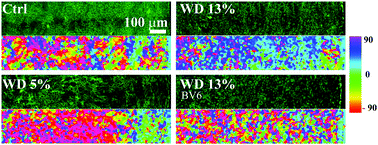当前位置:
X-MOL 学术
›
Integr. Biol.
›
论文详情
Our official English website, www.x-mol.net, welcomes your
feedback! (Note: you will need to create a separate account there.)
Adaptive reorientation of endothelial collectives in response to strain
Integrative Biology ( IF 1.5 ) Pub Date : 2018-08-16 , DOI: 10.1039/c8ib00092a Laura Bernardi 1, 2, 3, 4 , Costanza Giampietro 1, 3, 4, 5 , Vita Marina 1, 2, 3, 4 , Martina Genta 1, 2, 3, 4 , Edoardo Mazza 1, 2, 3, 4, 6 , Aldo Ferrari 1, 1, 2, 3, 4
Integrative Biology ( IF 1.5 ) Pub Date : 2018-08-16 , DOI: 10.1039/c8ib00092a Laura Bernardi 1, 2, 3, 4 , Costanza Giampietro 1, 3, 4, 5 , Vita Marina 1, 2, 3, 4 , Martina Genta 1, 2, 3, 4 , Edoardo Mazza 1, 2, 3, 4, 6 , Aldo Ferrari 1, 1, 2, 3, 4
Affiliation

|
Mature epithelial monolayers share the ability to coherently respond to external mechanical stimuli. Tissue remodeling requires cell shape changes and coordinated movements. Human endothelia provide an exquisite example of such emerging collective activities. As part of their function in maintaining body homeostasis under variable hemodynamic loadings, endothelial ensembles must dynamically adapt to wall shear stress and cyclic deformation. While the alignment of several types of cells, including fibroblasts, osteoblasts and epithelial tissues, in response to various flow conditions or wall shear stress levels has been described in detail, less is known about collective endothelial remodeling under pure wall deformation. Here, using a custom-developed bioreactor, we exposed mature human endothelia to two distinct physiological levels of cyclic loading, generating overlapping gradients of strain. Endothelial cells remodeled depending on the level of imposed strain yielding local variations of cell density. In particular, a collective cell orientation orthogonal to the main direction of strain was observed at low levels of wall deformation, while cells reoriented parallel to the main direction of strain at high levels of wall deformation. The tissue adaptation depended on the establishment of mature adherens junctions, which were reinforced by the polarized recruitment of the adaptor protein vinculin. The pivotal role of cell-to-cell junctions was confirmed by the biochemical inhibition of vascular endothelial cadherin homotypic contacts, which impaired the collective remodeling. Together, our data establish wall deformation as an independent determinant of endothelial architecture with direct implications in vascular physiopathology.
中文翻译:

应变对内皮细胞集合体的适应性重新定向
成熟的上皮单层细胞具有对外部机械刺激连贯反应的能力。组织重塑需要细胞形状改变和协调的运动。人类内皮细胞提供了这种新兴的集体活动的精妙例子。作为在可变的血流动力学负荷下维持体内稳态的功能的一部分,内皮细胞必须动态适应壁切应力和周期性变形。尽管已经详细描述了响应于各种流动条件或壁切应力水平的几种类型的细胞(包括成纤维细胞,成骨细胞和上皮组织)的排列,但对于纯壁变形下的集体内皮重塑知之甚少。在这里,使用定制开发的生物反应器,我们将成熟的人类内皮细胞暴露于两个不同的生理水平的循环负荷下,从而产生重叠的应变梯度。内皮细胞重塑取决于施加的应变水平,从而产生细胞密度的局部变化。尤其是,在壁变形水平较低时,观察到与应变主方向正交的整体单元取向,而在壁变形水平较高时,单元平行于应变主方向重新取向。组织适应性取决于成熟的粘附连接的建立,其通过衔接蛋白纽扣蛋白的极化募集而得以加强。细胞间连接的关键作用已被生化抑制血管内皮钙黏着蛋白同型接触所证实,这损害了集体重塑。一起,
更新日期:2018-08-16
中文翻译:

应变对内皮细胞集合体的适应性重新定向
成熟的上皮单层细胞具有对外部机械刺激连贯反应的能力。组织重塑需要细胞形状改变和协调的运动。人类内皮细胞提供了这种新兴的集体活动的精妙例子。作为在可变的血流动力学负荷下维持体内稳态的功能的一部分,内皮细胞必须动态适应壁切应力和周期性变形。尽管已经详细描述了响应于各种流动条件或壁切应力水平的几种类型的细胞(包括成纤维细胞,成骨细胞和上皮组织)的排列,但对于纯壁变形下的集体内皮重塑知之甚少。在这里,使用定制开发的生物反应器,我们将成熟的人类内皮细胞暴露于两个不同的生理水平的循环负荷下,从而产生重叠的应变梯度。内皮细胞重塑取决于施加的应变水平,从而产生细胞密度的局部变化。尤其是,在壁变形水平较低时,观察到与应变主方向正交的整体单元取向,而在壁变形水平较高时,单元平行于应变主方向重新取向。组织适应性取决于成熟的粘附连接的建立,其通过衔接蛋白纽扣蛋白的极化募集而得以加强。细胞间连接的关键作用已被生化抑制血管内皮钙黏着蛋白同型接触所证实,这损害了集体重塑。一起,











































 京公网安备 11010802027423号
京公网安备 11010802027423号